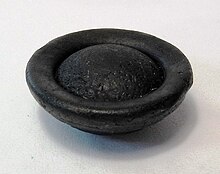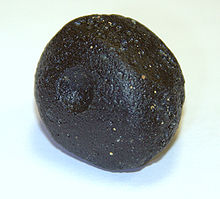您尚未参与本次拍卖。
MOLDIVATE PENDANT FACETED -SILVER 8.00 CTS [SJ1021]
- 存货单位
- 尺寸(毫米)
- x x mm
- 重量 (cts)
- 颜色
-
SEDA JEWELERY
MOLDIVATE
This is a natural untreated specimen hand selected for it unique structure.We have left one side natural and the front is faceted.It is app 15 million years old and it is from the Moldau valley in the czeh republic.It has been set in silver and ready to wear.
Sliver stamped 925
Weight of both silver and stone 8.00 cts app
Size 16 x 9 x 5 mm app
Tektites (from Greek tektos, molten) are natural glass rocks up to a few centimeters in size, which most scientists argue were formed by the impact of large meteorites on Earth's surface. Tektites are typically black or olive-green, and their shape varies from rounded to irregular.
Tektites are among the "driest" rocks, with an average water content of 0.005%. This is very unusual, as most if not all of the craters where tektites may have formed were underwater before impact. Also, partially melted zircons have been discovered inside a handful of tektites. This, along with the water content, suggests that the tektites were formed under phenomenal temperature and pressure not normally found on the surface of the Earth.
The terrestrial-impact theory states that a meteorite impact melts material from the Earth's surface and catapults it up to several hundred kilometers away from the impact site, which means that it must have travelled through space (thus explaining the dryness). The molten material cools and solidifies to glass. According to this theory, a meteorite impact causes their formation, but the precursor material of tektites is primarily of terrestrial origin, as determined from isotopic measurements. Today, the terrestrial origin of tektites is widely accepted based on the results of many geochemical and isotopic studies (e.g. Faul H.(1966), Koeberl C.(1990)).
The impact theory relies on the observation that tektites cannot be found in most places on Earth's surface. They are only found in four strewnfields, three of which are associated with known impact craters. Only the largest and geologically youngest tektite deposit in Southeast Asia, called the Australasian strewnfield has not been definitively linked to an impact site, probably because even very large impact structures are often not easy to detect. For example, since the Chesapeake Bay impact crater,(today the largest known impact structure of the United States and associated with the North American tektite strewnfield) is covered by sediments, it was not detected until the early 1990s. Also, the bigger the strewnfield, the bigger the area to search for the crater. Since several new craters are identified every year, this is not really regarded as a problem by proponents of the tektite impact theory, except for the expected Australasian crater, a feature that would be less than a million years old and thus easily visible. This crater, if it exists at all, has not been located.
The ages of tektites from the four strewnfields have been determined using radiometric dating methods. The age of moldavites, a type of tektite found in Czech Republic, was determined to be 14 million years, which agrees well with the age determined for the Nördlinger Ries crater (a few hundred kilometers away in Germany) by radiometric dating of Suevite (an impact breccia found at the crater). Similar agreements exist between tektites from the North American strewnfield and the Chesapeake Bay impact crater and between tektites from the Ivory Coast strewnfield and the Lake Bosumtwi-Crater.
Early non-terrestrial impact theories

Though the meteorite impact theory of tektite formation is widely accepted, minority theories propose alternate ideas of tektite formation.
Tektites contain no cosmogenic noble gases produced by cosmic rays, a factor that excludes long travel in space, necessary if tektites are not terrestrial. According to terrestrial-impact adherents, this makes a lunar origin unlikely, because it is hard to reconcile with finding cosmogenic noble gases in all lunar meteorites – a typical lunar meteorite taking about 1 million years to transfer from Moon to Earth. Furthermore, an origin from the Moon or other body cannot explain why many tektites are only found in confined areas unlike meteorites of lunar or other origin, which are found dispersed on the Earth's surface. Whether the Australasian and Ivory Coast tektites fit this thesis is debatable.
In particular, no tektite strewn field exists in Antarctica, where the flow of glaciers would sweep extraterrestrial material away. Since the Australasian strewnfield expands with each new tektite discovered on the southern seafloor, this tektite field may yet be found to reach as far as Antarctica, but regularly undertaken meteorite recovery expeditions in areas that accumulate extraterrestrial material have found only meteorites and no tektites at all. If tektites from space fall in Antarctica, a large part of the recovered material should instead be tektites and an existing strewnfield should already have been discovered. Conversely, the Australasian and Ivory Coast strewnfields have expanded over the decades as new tektites are found in sea sediments; they now reach toward the southern continent. Thus, it may be premature for terrestrial-origin proponents to say that tektites will never be discovered on Antarctica.
- 存货单位
- 尺寸(毫米)
- x x mm
- 重量 (cts)
- 颜色
-
SEDA JEWELERY
MOLDIVATE
This is a natural untreated specimen hand selected for it unique structure.We have left one side natural and the front is faceted.It is app 15 million years old and it is from the Moldau valley in the czeh republic.It has been set in silver and ready to wear.
Sliver stamped 925
Weight of both silver and stone 8.00 cts app
Size 16 x 9 x 5 mm app
Tektites (from Greek tektos, molten) are natural glass rocks up to a few centimeters in size, which most scientists argue were formed by the impact of large meteorites on Earth's surface. Tektites are typically black or olive-green, and their shape varies from rounded to irregular.
Tektites are among the "driest" rocks, with an average water content of 0.005%. This is very unusual, as most if not all of the craters where tektites may have formed were underwater before impact. Also, partially melted zircons have been discovered inside a handful of tektites. This, along with the water content, suggests that the tektites were formed under phenomenal temperature and pressure not normally found on the surface of the Earth.
The terrestrial-impact theory states that a meteorite impact melts material from the Earth's surface and catapults it up to several hundred kilometers away from the impact site, which means that it must have travelled through space (thus explaining the dryness). The molten material cools and solidifies to glass. According to this theory, a meteorite impact causes their formation, but the precursor material of tektites is primarily of terrestrial origin, as determined from isotopic measurements. Today, the terrestrial origin of tektites is widely accepted based on the results of many geochemical and isotopic studies (e.g. Faul H.(1966), Koeberl C.(1990)).
The impact theory relies on the observation that tektites cannot be found in most places on Earth's surface. They are only found in four strewnfields, three of which are associated with known impact craters. Only the largest and geologically youngest tektite deposit in Southeast Asia, called the Australasian strewnfield has not been definitively linked to an impact site, probably because even very large impact structures are often not easy to detect. For example, since the Chesapeake Bay impact crater,(today the largest known impact structure of the United States and associated with the North American tektite strewnfield) is covered by sediments, it was not detected until the early 1990s. Also, the bigger the strewnfield, the bigger the area to search for the crater. Since several new craters are identified every year, this is not really regarded as a problem by proponents of the tektite impact theory, except for the expected Australasian crater, a feature that would be less than a million years old and thus easily visible. This crater, if it exists at all, has not been located.
The ages of tektites from the four strewnfields have been determined using radiometric dating methods. The age of moldavites, a type of tektite found in Czech Republic, was determined to be 14 million years, which agrees well with the age determined for the Nördlinger Ries crater (a few hundred kilometers away in Germany) by radiometric dating of Suevite (an impact breccia found at the crater). Similar agreements exist between tektites from the North American strewnfield and the Chesapeake Bay impact crater and between tektites from the Ivory Coast strewnfield and the Lake Bosumtwi-Crater.
Early non-terrestrial impact theories

Though the meteorite impact theory of tektite formation is widely accepted, minority theories propose alternate ideas of tektite formation.
Tektites contain no cosmogenic noble gases produced by cosmic rays, a factor that excludes long travel in space, necessary if tektites are not terrestrial. According to terrestrial-impact adherents, this makes a lunar origin unlikely, because it is hard to reconcile with finding cosmogenic noble gases in all lunar meteorites – a typical lunar meteorite taking about 1 million years to transfer from Moon to Earth. Furthermore, an origin from the Moon or other body cannot explain why many tektites are only found in confined areas unlike meteorites of lunar or other origin, which are found dispersed on the Earth's surface. Whether the Australasian and Ivory Coast tektites fit this thesis is debatable.
In particular, no tektite strewn field exists in Antarctica, where the flow of glaciers would sweep extraterrestrial material away. Since the Australasian strewnfield expands with each new tektite discovered on the southern seafloor, this tektite field may yet be found to reach as far as Antarctica, but regularly undertaken meteorite recovery expeditions in areas that accumulate extraterrestrial material have found only meteorites and no tektites at all. If tektites from space fall in Antarctica, a large part of the recovered material should instead be tektites and an existing strewnfield should already have been discovered. Conversely, the Australasian and Ivory Coast strewnfields have expanded over the decades as new tektites are found in sea sediments; they now reach toward the southern continent. Thus, it may be premature for terrestrial-origin proponents to say that tektites will never be discovered on Antarctica.
| 运输商 | 运送至:国家 | 运送到世界其他地区 |
|---|---|---|
| FedEx | $12.00 / :几天天 | $39.00 / :几天天 |
|
:国家
FedEx 对包含 2 或更多商品的订单折扣为 $12.00
世界其他地区
FedEx 对包含 2 或更多商品的订单折扣为 $39.00
|
||
| Registered Shipping | $9.00 / :几天天 | $16.00 / :几天天 |
|
:国家
Registered Shipping 对包含 2 或更多商品的订单折扣为 $9.00
世界其他地区
Registered Shipping 对包含 2 或更多商品的订单折扣为 $16.00
|
||
-
 积极的
积极的A gorgeous piece. Well packaged and promptly posted. Would definitely recommend Seda Jewelery
-
 积极的
积极的Paid and shipped - no feedback left after 100 days
-
 积极的
积极的Paid and shipped - no feedback left after 100 days
-
 积极的
积极的Paid and shipped - no feedback left after 100 days
为什么用户出价高于自己?
出价时,这是用户愿意为产品出价的最高金额。然后,我们的系统将代表该用户自动出价,逐步提高出价以保持其作为最高出价者的地位,直至达到指定的最高价。
当出现“自动出价”图标时,表示我们的系统正在根据用户的最高出价主动为用户出价。这可能看起来好像用户出价高于自己,但这只是系统更新出价以反映用户最高限制的结果。










![FOSSIL PENDANT -ORTHOCERAS 50.80 CTS [GT 2202]](https://liveplatforms-production.b-cdn.net/tenants/gr/uploads/images/565000-569999/565609/176163_1271056162.jpg?width=480&aspect_ratio=1001%3A1000)
![SIZE 7 PINK AUSTRALIAN SAPPHIRES SET IN SILVER RING [SJ4543]](https://liveplatforms-production.b-cdn.net/tenants/gr/uploads/images/675000-679999/678314/595592ed09b4b.jpg?width=480&aspect_ratio=1001%3A1000)
![34.00 CTS LAPIS PENDANT-SILVER FACTORY DIRECT [SJ4340]](https://liveplatforms-production.b-cdn.net/tenants/gr/uploads/images/715000-719999/718539/5a371c851b0d9.jpg?width=480&aspect_ratio=1001%3A1000)
![200.00 CTS NEPAL BEAD PARCEL-CORAL TURQUOISE [SJ2659]](https://liveplatforms-production.b-cdn.net/tenants/gr/uploads/images/560000-564999/564936/31604_1359090725.jpg?width=480&aspect_ratio=1001%3A1000)
![95.00 CTS NEPAL BEAD PARCEL-CORAL TURQUOISE [SJ2642]](https://liveplatforms-production.b-cdn.net/tenants/gr/uploads/images/560000-564999/564723/31578_1359087469.jpg?width=480&aspect_ratio=1001%3A1000)





